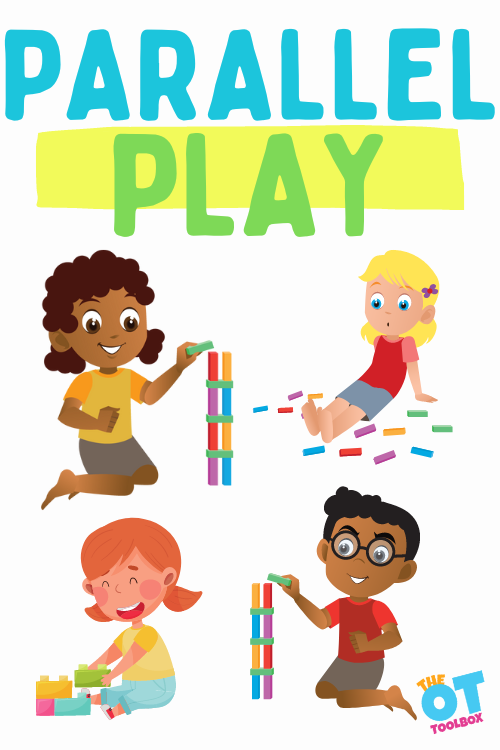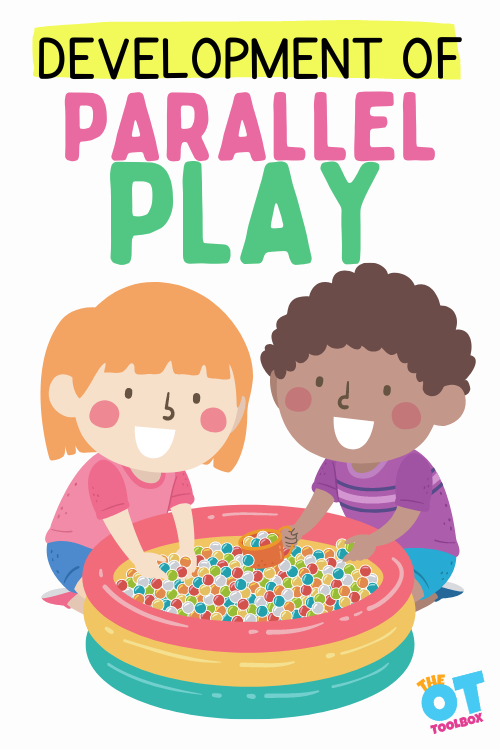In this blog we will discuss the importance of parallel play in young children, its benefits, and ways adults can support social skill development with young toddlers through this type of play. One aspect of occupational therapy play, parallel play is both a tool and a main job of kids!

What is parallel play?
Parallel Play refers to, playing near or alongside another person. It is a developmental phase of childhood development. The act of participating in building social boundaries by playing along side a peer offers a variety of learning opportunities, especially when adults facilitate interactions through creating an engaging environment.
This stage of play is a crucial stepping stone in navigating friendships. It’s an opportunity to practice social interactions in a “safe” manner as young children play side-by-side.
parallel play age
Parallel play occurs between the ages of 18 months to 2 years of age. Although this age range is a common stage for many children, parallel play can exist beyond the age of two years. This play age is when we see a lot of growth.
Children of all ages can play near or alongside a peer.
Even adults can participate in leisure activities using parallel play!

Development of parallel play
Parallel play occurs when children play in groups, in preschool classrooms, day care centers, playdates, or in small groups, including alongside siblings. Playmates that play beside one another may be using the same toys or playthings or they may be using different toys.
It’s an opportunity to build social skills by observing a peer, using new words and building on language development, seeing new vocabulary in action, exploring different scenarios, exploring social behavior, even at a young age.
Parallel play is a process in social emotional learning and social emotional development, and includes practice in the social development that might not happen in stages of play prior to parallel play (unoccupied play, solitary play, and onlooker play).
Because parallel play requires proximity to other children, it’s a great way to practice the skills needed for play stages after parallel play as well, leading to a healthy development of social awareness.
There are six stages of play in early childhood including:
- Unoccupied play
- Solitary play
- Onlooker play
- Parallel play
- Associative play
- Cooperative play
Parallel play is the fourth stage of play development, and the beginning of children exploring relationships with those around them. Child development is centered on play and parallel play is just one of those stages
Parallel Play is one of six stages of development!
Parallel play is just one of the six stages of play. As children navigate sharing space and toys with peers, they are learning communication, sensory, spatial awareness and other developmental milestones in a group setting.
History of Play development
The history of parallel play is discussed in this blog stating that, “Parallel play (or parallel activity) is a term that was introduced by Mildred Parten in 1932 to refer to a developmental stage of social activity in which children play with toys like those the children around them are using, but are absorbed in their own activity, and usually play beside rather than with one another.”
There have been many different studies done on play. One of the most well-known educational philosopher, Maria Montessori, highlights the importance of all stages of play within her research.
Benefits of parallel play
During this parallel play stage, children in this age range learn:
- Language and communication skills
- Sharing/taking turns
- Motor planning skills
- Self regulation
- Creativity
- Fine motor skills and gross motor skills
- Emotions/expression
- Independence and confidence
- Social cues from peers
- Social and personal boundaries
- Body awareness
- Awareness of surroundings
- Fine motor skills
You can see how parallel play is a powerful tool for learning during the preschool years!
Examples of Parallel Play
You have probably seen parallel play in action in the classroom, home, or anywhere more than one child are interacting together in play experiences.
When observing play at a park, children between the ages of 2 and 3 engage in parallel play as they interact with toys in the same area, such as the sandbox.
As they dig and pour the sand, children may allow others into their space, but don’t acknowledge what they are doing, or try to join their play.
- Playing alongside one another using similar toys in a pretend play area in a preschool classroom
- Playing in a shared space with different toys such as blocks and dolls
- Engaging in DIR Floor Play alongside an adult
- Playing in a shared environment with similar toys or experiences, but with individual play experiences (in a block center where each child builds their own blocks, in a play dough center where each child plays with their own play dough, etc.)
- Playing on playground equipment at a school playground where each child uses similar or different equipment and participates in their own pretend scenarios
While children are in the imitation stage, adults can support their development by providing large areas where many children can play near each other with similar toys. This includes investigative art opportunities, large motor play, block areas, book areas and open ended spaces.
Parallel Play Activities
Here are five fun parallel play games for you to try.
- Investigating art – In the Reggio Emilia philosophy of early childhood education, the atelier (art studio) is a focal point of the classroom. Children of any age, and in any play stage, benefit from exploring different types of art materials. For the child engaging in parallel play, observations of other individuals are often made. Whether indoors or out, providing children with different art supplies, will draw interest in the shared space. Set up this space by providing seating areas that are safe to explore paints, clay, recycled materials and more.
- Sensory exploration – Parallel play development can be developed in sensory play. Sensory bins, tubs, and activities provide the opportunity for multiple children to engage in tactile exploration at the same time. Although they may not be engaging directly with the children in their group, they will be enthusiastic about standing/sitting near others. Sensory bins can be filled with a variety of items that are readily available, such as sand, rice, rocks, grass, birdseed, or water. They can also be seasonally themed, like these fall sensory ideas. Messy sensory play with shaving cream is a great tactile activity.
- Building areas – blocks, Legos, Lincoln logs, tinker toys, train tracks, and other building materials are fun for children of any age to promote parallel play. A block area creates a smaller space with a variety of opportunities children enjoy. A building area can be set up in the classroom or a home. Scaffolding the learning environment, where adults lay out items that encourage children to explore topics and practice new skills, is a wonderful way to support parallel play. A block area can includes hard hats, road signs, books about building, plastic animals, and more!
- Storybook access – A library filled with different types of books interesting to young children is a perfect parallel play environment. As children pick out the book they like, sit on a bean bag or carpet square to read, they are actively being part of a small reading group. Adding some baby dolls, stuffed animals, blankets and pillows entices young children to stay in the reading nook longer. Some classrooms put up a small tent for reading time, or build a treehouse loft in the class.
- Small group fine motor play- A small table with four or five chairs is the perfect spot to set up a fine motor activity for the age level you are teaching. This parallel play set up is ideal, allowing young children to have their own space, while still playing near familiar children. Examples of activities to include in this area are stacking cups, building block towers, muffin tin sorting, scissor skill activities, rainbow chain links and play dough. You can find more ideas perfect for toddlers here on the OT Toolbox.
supporting children through conflict
When children are playing near each other, problems don’t often occur, but what happens when one child gets too close to another, or they take a toy that another child is playing with?
Sometimes children become frustrated with the actions of their peers, and need extra visual and tactile support to navigate calming down and problem solving. As children become more comfortable with parallel play through fun and engaging activities, they are able to develop foundational skills necessary for social and emotional development.
As children are developing their play skills, they often need support from adults on how to communicate appropriately. Using visual and tactile tools to support calm down and problem solving skills are necessary when engaging with toddlers who are having big emotions.
Once a child is calm, supporting their conflict negotiation skills through simple questions and narrating the situation, will help toddlers find a solution and also learn skills needed to communicate with peers in the future.
Some short phrases to use with toddlers when helping them identify the cause of their frustration and problem solving are:
- I see that _________ took/grabbed/kicked/etc_____________.
- You seem mad. What happened?
- ___________wanted to be closer to you, but you didn’t want that.
- How can I help you ______________?
- What would you like to do instead?
- Do you need a break?
- Would you like to try _______ instead?
One program that includes easy-to-understand calming activities for two years olds is the (Amazon affiliate link) Soothing Sammy program I developed.
It includes a story about Sammy, a golden retriever, who lives in a house that children visit when they are sad or upset. Sammy supports children through processing their feelings by sharing with them a variety of sensory objects (water, cold washcloth, crunchy snack, a spot to jump, and more!)
Although parallel play is a short term developmental stage, it is an important step that bridges the gap from independent exploration to building collaborative friendships. Teachers, caregivers, and parents play a critical role in providing safe and interesting opportunities for children to play and socialize with others.

Jeana Kinne is a veteran preschool teacher and director. She has over 20 years of experience in the Early Childhood Education field. Her Bachelors Degree is in Child Development and her Masters Degree is in Early Childhood Education. She has spent over 10 years as a coach, working with Parents and Preschool Teachers, and another 10 years working with infants and toddlers with special needs. She is also the author of the “Sammy the Golden Dog” series, teaching children important skills through play.






